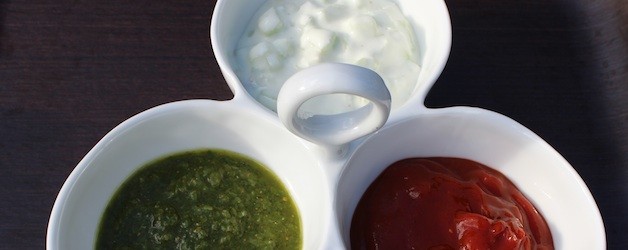

Be Saucy
Zest up lunch or dinner with tasty dipping sauces for raw and cooked vegetables, proteins, and breads. Making your own sauces is fast, easy, and allows you to skip the artificial sweeteners or preservatives used in many pre-made sauces. Expand beyond ketchup, mustard, or ranch with these healthy alternatives. You probably have most or all of the ingredients for these sauces already, so all you need to do is spend about 5 minutes putting them together. Once you make the sauce, it will keep in the refrigerator for a number of days or longer, depending on the sauce, so you can use it as a condiment for multiple meals: salad dressing, protein marinade, a dipping sauce for packed lunches, or a topping for pasta, rice, or grain.
Explore and enjoy!
Yogurt-based Dipping Sauces:
Yogurt is a nutrient-rich base for a great variety of dipping sauces. Plain yogurt can be combined with sour cream, cream cheese, feta, or ricotta for a variation of flavors and textures.
Cucumber Yogurt Sauce (Raita)
- 1 cup whole milk plain yogurt
- 1 teaspoon minced garlic
- 1 cup cucumber (about 1 cucumber) peeled, seeded, and minced
- Kosher or coarse salt and freshly ground black pepper
Stir all ingredients together. Serve immediately or refrigerate for later. Enjoy!
Serve with: Grilled chicken; raw vegetables (carrots, celery, bell pepper, mushrooms, radishes, snap peas); fish; pita bread; falafel balls.
Nut or Seed Butter Sauce:
This great recipe for peanut dipping sauce can be used as a dipping sauce, dressing for a green salad, or sauce for cooked noodles served hot or cold. Any nut butter, soy butter, or sunflower seed butter can be substituted for the peanut butter in the recipe.
Peanut Dipping Sauce from Cook’s Illustrated.
- 1/4 cup smooth peanut butter
- 1/4 cup hoisin sauce
- 1/4 cup water
- 2 tablespoons tomato paste
- 1 teaspoon Asian chili sauce (optional)
- 2 teaspoons peanut oil or vegetable oil
- 2 medium cloves garlic, minced or pressed through garlic press
- 1 teaspoon red pepper flakes
Whisk peanut butter, hoisin sauce, water, tomato paste, and chili sauce, if using, in small bowl. Heat oil, garlic, and red pepper flakes in small saucepan over medium heat until fragrant, 1 to 2 minutes. Stir in peanut butter mixture; bring to simmer, then reduce heat to medium-low and cook, stirring occasionally, until flavors blend, about 3 minutes. (Sauce should have ketchup-like consistency; if too thick, add water, 1 teaspoon at a time, until proper consistency is reached.) Transfer to bowl; cool to room temperature.
Serve with: Spring rolls; cucumber spears; noodles; cubed firm tofu; broiled or grilled shrimp.
BBQ or Honey Mustard dipping sauces offer sweet and zesty flavors good with grilled meats and raw or roasted vegetables.
Barbecue Sauce from The Mom 100 Cookbook by Katie Workman
- 2 tablespoons vegetable or canola oil
- 1 ½ cups chopped onion
- 2 tablespoons finely chopped garlic
- 4 cups ketchup, preferably Heinz*
- ½ cup cider vinegar
- ¼ cup firmly packed light or dark brown sugar
- ¼ cup honey
- ¼ cup tomato paste
- 3 tablespoons Worcestershire sauce
- 2 tablespoons Dijon mustard
- 1 tablespoon chili powder
- Kosher or coarse salt and freshly ground pepper
Heat the oil in a large saucepan over medium heat. Add the onion and garlic. Cook, stirring occasionally, until slightly softened, about 3 minutes (don’t let the onion and garlic get more than light golden in color). Add the ketchup, cider vinegar, brown sugar, honey, tomato paste, Worcestershire sauce, mustard, and chili powder. Season the sauce with salt and pepper to taste, stir well, and let simmer over medium low heat until the flavors meld, about 15 minutes. If you like your sauce a bit chunky with the chopped onions, it’s ready to go. If you like it nice and smooth, let it cool a bit and then puree it in a blender or food processor, or use an immersion blender.
*Look for Simply Heinz – a catsup that tastes just like Heinz traditional ketchup without the high fructose corn syrup.
Serve with: Cubed chicken or chicken nuggets; baked sweet potato fries; rolled up deli meats; steamed green beans; pretzels (soft or hard).
Pesto dipping sauce traditionally has a basil base but can be made with sun-dried tomatoes, parsley, cilantro, mint, spinach and pine nuts, walnuts, sunflower seeds.
Traditional Pesto (Pesto Genovese) from How to Cook Everything by Mark Bittman
- 2 cups loosely packed cups fresh basil leaves, rinsed and dried
- Salt
- ½ clove garlic, peeled, or more to taste
- 2 tablespoons pine nuts or chopped walnuts*
- ½ cup extra virgin olive oil, or more if desired
- ½ cup freshly grated Parmesan, pecorino Romano, or other hard cheese (optional)
Combine the basil with a pinch of salt, the garlic, the nuts, and about half the oil in a food processor or blender. Process, stopping to scrape down the sides of the container if necessary and adding the rest of the oil gradually. Add more oil if you prefer a thinner mixture. Store in the refrigerator for a week or two, or in the freezer for several months. Stir in the cheese by hand just before serving.
*Look on-line for a nut-free pesto recipe if you have a nut allergy in your family.
Serve with: Cooked pasta; mini fresh mozzarella balls (or string cheese); whole wheat bread sticks; roasted small potatoes; raw, steamed, or roasted cauliflower.
Variations: There are hundreds of variations for these dipping sauces. For loads of ideas and recipes on creating variations, see one of our favorite cookbooks: How to Cook Everything by Mark Bittman.
Speedy version: All of these sauces can be purchased fresh or preserved. Look for sauces with the least number of preservatives (the freshest sauces are usually in the refrigerated cases), and sauces without high fructose corn syrup.
